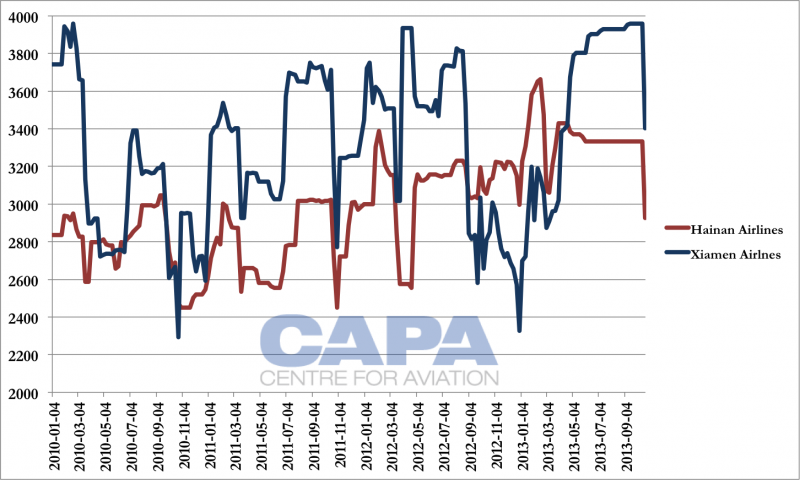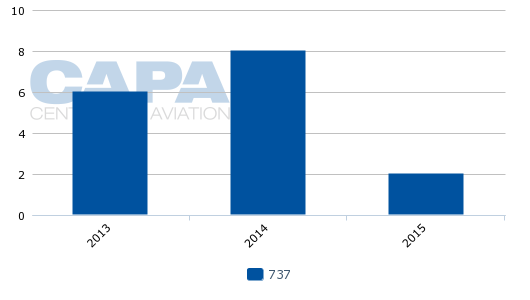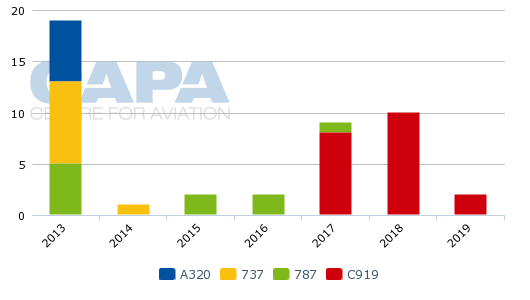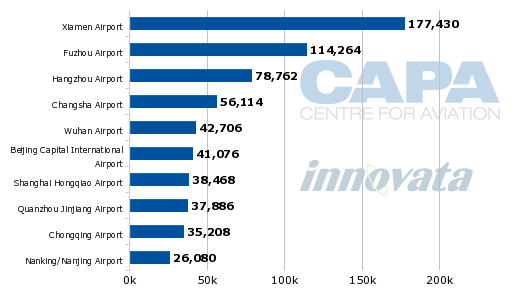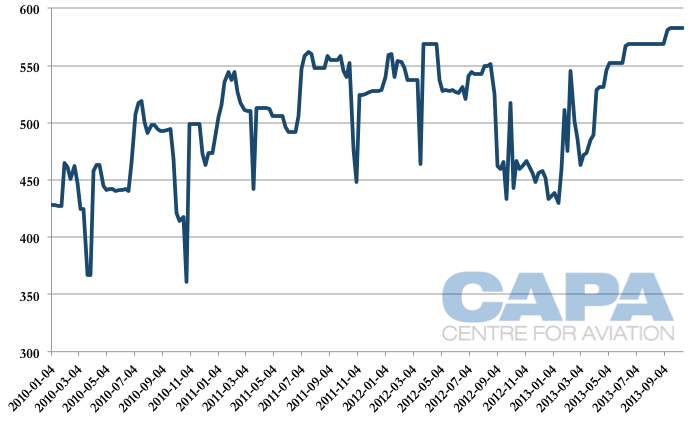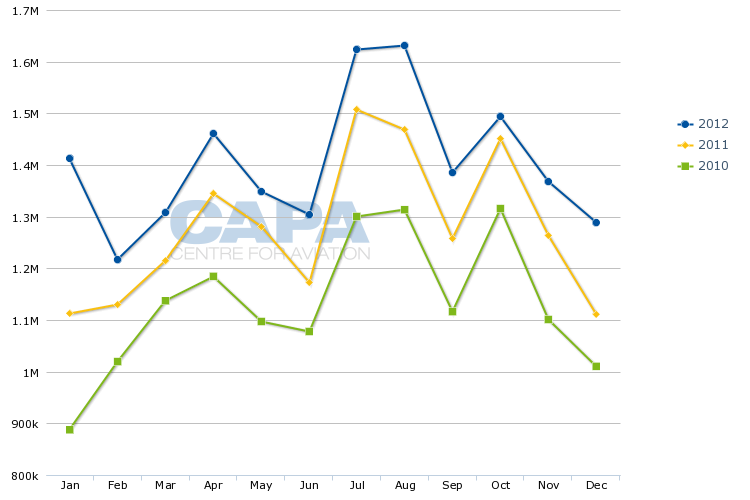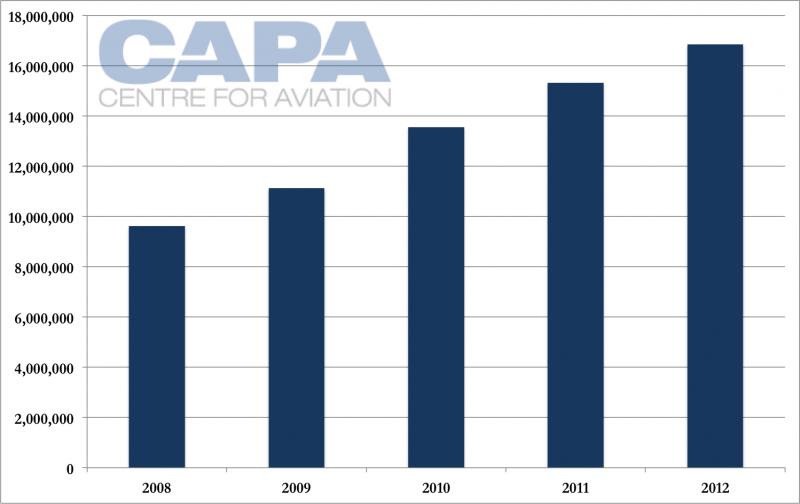Xiamen Airlines, China's fourth largest domestic airline, aims to surpass 20m pax in 2013
Privately-owned carrier Xiamen Airlines has regained its position as China's fourth largest airline after a drop in capacity in 2H2012 and early 2013 when measured on available domestic and seat capacity and frequency. This places Xiamen as the world's 27th largest airline by seat capacity - larger than perhaps better-known carriers including KLM, Korean Air and Cathay Pacific. While those carriers eclipse Xiamen when weighing available seat kilometres, Xiamen as the 51st largest on ASKs is still larger than Air New Zealand, Finnair or Vueling.
This strong domestic carrier - 94% of seat capacity is within mainland China - will accelerate growth of its small international footprint by adding services around Southeast Asia following its ascension to SkyTeam in late 2012. But the domestic Chinese market remains its focus, and Xiamen will use many of the 15 737-800s it is receiving this year to grow its presence around its namesake home of Xiamen. Despite the name connection, Xiamen Airlines has more capacity outside of Xiamen than it does to or from the city. In 2013 Xiamen Airlines aims to break the 20 million threshold for annual passengers carrier, and also carry over 200,000 tons of cargo and mail.
Xiamen Airlines larger than Hainan Airlines - but HNA Group larger than Xiamen
While Xiamen Airlines has regained its position from privately-owned Hainan Airlines as China's fourth largest airline, further movement up in the rankings could be difficult: while Xiamen will capture 7.5% of domestic capacity, the third largest domestic airline, Air China, will have nearly twice the capacity at 13.2%.
China Eastern as the second largest will have 18.6% and the largest, China Southern, 22.1%.
Hainan Airlines and Xiamen Airlines weekly domestic frequency: 04-Jan-2010 to 21-Oct-2013
Hainan, like the so-called Big Three, operates a portfolio strategy with different AOCs under itself or part-owner HNA Group. Taking into account these domestic subsidiaries (and not Hong Kong Airlines and Hong Kong Express), HNA Group is slightly larger than Xiamen, with a 7.8% share of the market. This will grow as Hainan plans to launch three new domestic carriers, but Xiamen also plans to grow. What strategic benefit Hainan could have from bragging rights about size is not clear: its subsidiaries are separately branded ventures with little public recognition that they are part of one group, the way SilkAir is with Singapore Airlines or Dragonair with Cathay Pacific.
It is possible Hainan could not have a large presence in the cities it plans to serve without local support that favours a hometown carrier, but there are opportunities for Hainan to present a more united front. This may develop as it launches more high-profile subsidiaries.
Cross-ownership/partnership amongst Chinese carriers: Mar-2013
While Xiamen Airlines has no airline subsidiaries of its own, it is majority-owned by China Southern. China Southern - Asia's largest airline - is already far larger than the HNA Group, and adding Xiamen's capacity to the group would only further propel it higher than HNA.
Xiamen Airlines Fleet Summary: as at 21-Mar-2013
| Aircraft | In Service | In Storage | On Order |
|---|---|---|---|
| Total: | 88 | 0 | 16 |
| Boeing 737-700 | 15 | 0 | 0 |
| Boeing 737-800 | 67 | 0 | 16 |
| Boeing 757-200 | 6 | 0 | 0 |
Xiamen Airlines projected delivery dates for aircraft on order being purchased directly from manufacturers* as at 18-Mar-2013
Hainan Airlines Fleet Summary: as at 21-Mar-2013
| Aircraft | In Service | In Storage | On Order |
|---|---|---|---|
| Total: | 108 | 0 | 45 |
| Airbus A320-200 | 0 | 0 | 6 |
| Airbus A330-200 | 9 | 0 | 0 |
| Airbus A330-300 | 2 | 0 | 0 |
| Airbus A330-300E | 3 | 0 | 0 |
| Airbus A340-600 | 3 | 0 | 0 |
| Boeing 737-300 | 1 | 0 | 0 |
| Boeing 737-400 | 3 | 0 | 0 |
| Boeing 737-700 | 3 | 0 | 3 |
| Boeing 737-800 | 80 | 0 | 6 |
| Boeing 767-300ER | 3 | 0 | 0 |
| Boeing 787-8 | 0 | 0 | 10 |
| Comac C919 | 0 | 0 | 20 |
| Dornier 328-300 | 1 | 0 | 0 |
Hainan Airlines projected delivery dates for aircraft on order being purchased directly from manufacturers* as at 18-Mar-2013
Xiamen to add growth around Southeast Asia
Xiamen's international growth - 14.7% year-over-year - will primarily be around Southeast Asia, with the exception of a daily Quanzhou-Hong Kong service to start in Apr-2013, when Shenzhen Airlines will increase its Quanzhou-Hong Kong service to three times daily. Quanzhou is Xiamen Airlines' eighth largest base but does not rank in the top 10 for Shenzhen Airlines, although the two are the largest carriers at Quanzhou.
Opportunities are more limited in Northeast Asia compared to Southeast Asia: the Hong Kong and Macau markets are limited (Spring is targeting Hong Kong but it is the underdog in the city, and has a lower cost base to facilitate expansion), Taiwan is full of potential but access remains heavily restricted, Japan is weak following political relations, and South Korea is limited as open skies only exists with Hainan and Shandong Provinces, outside of Xiamen's home.
Xiamen plans to add a service between Xiamen and Jakarta, its first in Indonesia. The route will also be Xiamen Airport's first link to Indonesia. The carrier also plans to resume its Bangkok service but has not yet announced the schedule. Xiamen plans to open 10 new routes in 2013.
China to Indonesia (seats per week, one-way): 19-Sep-2011 to 08-Sep-2013
Kuala Lumpur will be expanded with three weekly Fuzhou-Kuala Lumpur services complementing its four weekly Xiamen-Kuala Lumpur services. On the Kuala Lumpur sectors there will be a domestic tag between Fuzhou and Tianjin, and from Xiamen and Dalian.
Dalian and Tianjin are both in China's northeast. Tag services will be added to Singapore, with three weekly connections constructed between Dalian and Xiamen, continuing to Singapore.
The domestic tags can cause confusion in local reports as the services will be listed as new international links even if there is merely a domestic service timed to connect or the same aircraft journeys on both sectors. The tag services from Dalian to Xiamen (four weekly serving onward connections to both Singapore and Kuala Lumpur) and Fuzhou and Dalian are new domestic sectors.
The Southeast Asian market can be difficult for Chinese carriers.The region's LCCs - in a demonstration of their efficiency and low costs - can make Southeast Asia-China routes unprofitable at certain times of the year.
But no Southeast Asian LCC serves Xiamen or Fuzhou, Xiamen Airlines' two largest hubs. Besides the Xiamen Airlines capacity, Xiamen Airport is linked with passenger services to Singapore via daily SilkAir services and to Kuala Lumpur with four weekly services. No Southeast Asian airline serves Fuzhou (the only foreign carriers are from Hong Kong and Taiwan: Dragonair, Hong Kong Airlines, Uni Airways and TransAsia).
Xiamen Airlines top 10 hubs/bases/stations by system seats: 18-Mar-2013 to 24-Mar-2013
With Southeast Asian LCCs' large order books, cities like Fuzhou and Xiamen will soon come into focus as the new aircraft are delivered. After a period of growth into secondary Chinese cities, the Jetstar Group has quietened down. It will have more services to China from its forthcoming Hong Kong subsidiary. And AirAsia has been growing more quickly into mainland China from its Bangkok and Kuala Lumpur bases.
Domestic growth will be strong around the city of Xiamen
Domestic capacity growth is planned for 18.6%, and after building up other bases around China, Xiamen is focusing on its home for growth. In addition to the new Dalian-Xiamen service, Xiamen Airlines so far plans to increase frequency from Xiamen to Kunming, Chongqing continuing to Lhasa and Zhengzhou continuing to Xining. These are part of the 11 routes Xiamen Airlines plans to increase frequency on in 2013.
Xiamen Airlines' frequency in Xiamen has gone up and down in recent years, with a decline in the second half of 2012, but growth in 2013 will see it restore frequency to pre-2H2012 levels and then add beyond that.
Xiamen Airlines weekly domestic frequency from Xiamen: 04-Jan-2010 to 07-Oct-2013
Like domestic peers, Xiamen reported higher passenger volumes in every month of 2012 compared to 2011 on the back of strong domestic growth, even if growth is declining from the double-digit of previous years to high single-digit growth.
Xiamen Airlines monthly passenger numbers: 2010-2012
Xiamen Airlines annual passenger numbers: 2008-2012
Long-haul services to come in 2014 for the world's most profitable airline
Xiamen Airlines' strong domestic growth in 2013 will be followed in 2014 with its expansion to long-haul routes, furthering Xiamen's international footrprint and marking the first time it will operate services outside Asia. Its six 787s on order for delivery from 2014 are being considered for routes across Australia, Europe and North America. Xiamen will continue to look for synergies and partnership opportunities with its SkyTeam members.
See related articles:
- Greater private Chinese airline competition as Hainan's new Fuzhou Airlines tackles Xiamen Airlines
- After Xiamen and Shenzhen Airlines join SkyTeam and Star, where next for global alliances in China?
Xiamen's growth has been accompanied by profitability: the carrier posted a 2012 operating profit of RMB2 billion (USD321.9 million), up 17% year-over-year, and marking its 26th consecutive year of profitability, which by its own calculation makes it the world's most consistently profitable airline.
While 2013 may be a good year for growth, subsequent years will still be impressive: Xiamen aims to have a fleet of 200 aircraft by the end of 2020, indicating that aside from 787s it plans to take an average 13 new 737s every year for the rest of the decade.
